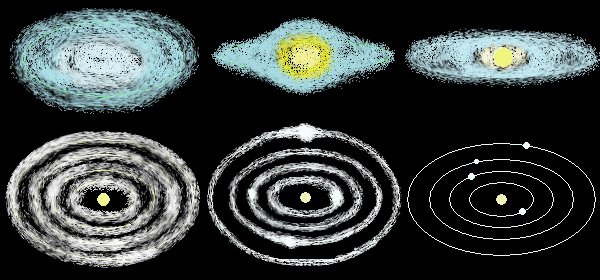There was a recent report in nature discussong how ice water was detected on the surface of an asteroid. One reason why this is a interesting is that it has often been thought that asteroids (in the asteroid belt) are too close to the sun to have frozen water. This led scientists to think water had to be carried to earth by comets as they usually stay far enough away from the sun to hold onto ice water. However, if asteroids do have frozen water n their surfaces the story can change.
Primer on Solar System Formation.
See the images above. I've included both pictures above as I am not sure which one is more helpful. These show how the solar system formed:
- Originally the solar system was a big "cloud" of gas and dust.
- The matter in the "cloud" collapses down to the center as gravity pulls it in. (Referred to as gravitational collapse.)
- The majority of the total mass of the cloud falls to the center and gets really hot. (A star is born)
- As the cloud collapses, it begines to spin quickly. (Think figure skater pulling in her arms.)
- Some large clumps of matter have just the right orbital velocity to stay in orbit without falling.
- If the large clumps are massive enough, they clear out their orbit so that there is only one massive "ball" left in orbit. (A planet.)
- Less massive things cannot clear out their orbit and so they form things like asteroid belts.
- We now have a mature solar system.
So Could Water Come From Asteroids?
Well, the earth was large enough to clear out its orbit. There were objects like the ones we see in the asteroid belt in Earth's orbit before the Earth pulled them in. If they had water on their surfaces, as the current ones do that are in the asteroid belt, then maybe they provided much water.
Furthermore, the earth may pull in modern asteroids if the get to close. However, this doesn't mean comets didn't contribute water as well.
Why Pluto Was Demoted.
This brings us to why Pluto was demoted from being classified as a planet: It did not clear out its orbit. (Pluto just loves Charon too much.)


How do water molecules form in space?
ReplyDeleteStan,
ReplyDeleteGood question. Believe it or not, water is prevalent in star forming regions. Two things:
1. The Hershel Space telescope which just released their first science findings found a ton of water throughout the universe.
2. Maybe this page shows a helpful description:
"Water is one of the most abundant and important molecules in star-forming regions. Although it is only a trace species in general molecular clouds, water becomes the third most abundant species in the warm regions created by the presence of newly-formed stars: the inner protostellar envelopes where the dust is warmer than the ice evaporation temperature, and the regions where the collapsing matter interacts with the powerful jets from the protostar causing violent shocks. This enormous variation in abundance makes water a unique probe of the physical structure of the region, and of the fundamental chemical processes within the gas and between the gas and the grains. "
Also, remember the hard part is coming up with Oxygen. Hydrogen was produced in great abundance during the Big Bang. However, once stars began to form Oxygen started to be created inside stars which then ejected that Oxygen through a variety of processes. The Oxygen then mixes with hydrogen at the right temperatures in star forming regions and water is produced.
ReplyDelete